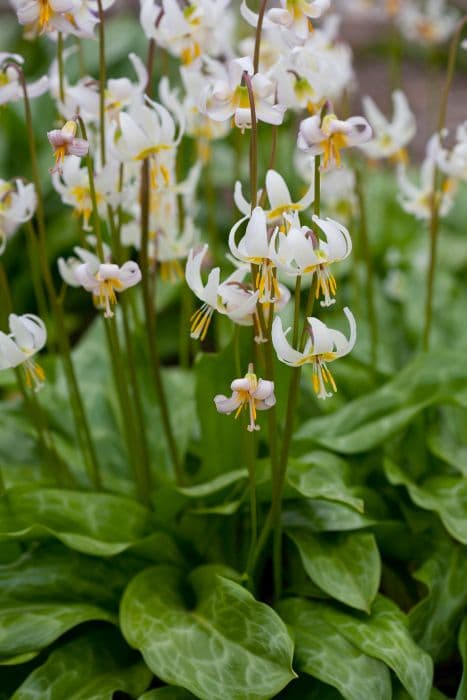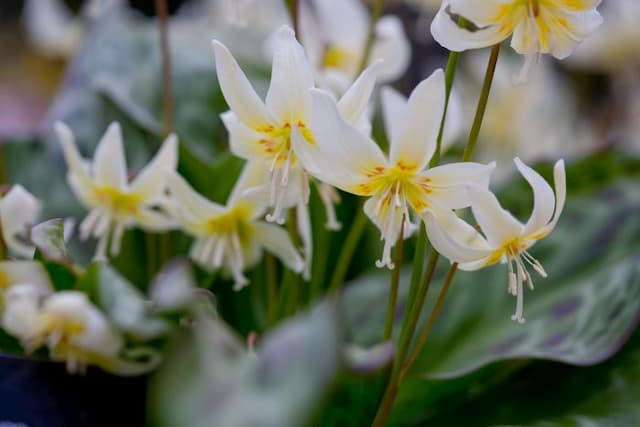Crown Imperial Fritillaria imperialis 'Argenteovariegata' (v)

ABOUT
The plant known as Crown Imperial 'Argenteovariegata' is a striking and ornamental flowering plant that stands out in any garden setting. It is characterized by a unique and bold structure with a tuft of bright green leaves that crown the top of the stem, much like a pineapple top. Below this topknot of foliage dangle large, pendulous bell-shaped flowers. The flowers themselves are a vibrant orange or red color, which makes them particularly eye-catching against the lush greenery. Additionally, the foliage has a variegated pattern—the 'Argenteovariegata' part of its name signifies the creamy white to pale yellow streaks or edges on the leaves, adding a decorative contrast and enhancing the overall appeal of the plant. The leaves are lance-shaped and glossy, arranged in a spiral formation along the stem, contributing to the exotic appearance. The flowers emit a distinct scent that can be quite strong and musky, often described as fox-like, which is noticeable especially when standing close to the plant. This combination of bright coloration, intricate variegation, and unique architecture makes the Crown Imperial 'Argenteovariegata' a prominent feature wherever it is planted.
About this plant
 Names
NamesFamily
Liliaceae
Synonyms
Silver Variegated Crown Imperial, Variegated Crown Imperial
Common names
Fritillaria imperialis 'Argenteovariegata'
 Toxicity
ToxicityTo humans
The Fritillaria imperialis, commonly known as the Crown Imperial, is considered to be of low toxicity to humans. However, if parts of the plant, such as the bulbs, are ingested, they may cause digestive upset, with symptoms like nausea, vomiting, and diarrhea. Contact with the sap may cause skin irritation in some individuals. While serious poisoning is uncommon, it is advised to seek medical attention if significant ingestion occurs or if symptoms are severe.
To pets
The Crown Imperial is also known to be of low toxicity to pets. If ingested, the plant can cause mild gastrointestinal upset in animals such as dogs and cats, with possible symptoms including vomiting and diarrhea. As pets can have varying reactions, if you suspect your pet has ingested part of a Crown Imperial plant, it is best to contact a veterinarian to determine the appropriate course of action.
 Characteristics
CharacteristicsLife cycle
Perennials
Foliage type
Deciduous
Color of leaves
Variegated
Flower color
Orange
Height
3 feet (0.91 meters)
Spread
1 foot (0.30 meters)
Plant type
Bulb
Hardiness zones
5
Native area
Middle East
Benefits
 General Benefits
General Benefits- Aesthetic Appeal: With its striking variegated foliage and vibrant orange-red flowers, Crown Imperial adds height and drama to the spring garden.
- Pest Deterrent: The plant has a distinct musky odor that can deter rodents, rabbits, and deer, protecting nearby plants.
- Easy Maintenance: Once established, the Crown Imperial is drought-tolerant and requires minimal care, making it suitable for gardeners of all skill levels.
- Perennial Growth: As a perennial, it will return year after year, providing long-term garden structure and color.
- Attracts Pollinators: Bees and other pollinating insects are attracted to its blossoms, aiding the health of the entire garden ecosystem.
- Architectural Interest: Its tall and unusual shape offers architectural interest to garden designs, working well in formal and informal settings.
 Medical Properties
Medical PropertiesThis plant is not used for medical purposes.
 Air-purifying Qualities
Air-purifying QualitiesThis plant is not specifically known for air purifying qualities.
 Other Uses
Other Uses- Fritillaria imperialis 'Argenteovariegata', also known as Crown Imperial, is sometimes used in the production of perfumes due to its unique fragrant flowers.
- The bulb of the Crown Imperial can be used as a source of starch for certain industrial applications such as biodegradable plastics and textiles.
- The plant's striking appearance makes it a popular choice for botanical art and illustration, providing inspiration for artists and being featured in botanical collections.
- The tall and eye-catching nature of Crown Imperial allows it to be used as a natural marker or border in landscaping to signal changes in garden areas or property lines.
- In some regions, the dried seeds of Crown Imperial are used for crafting jewelry or decorative items because of their unique shape and texture.
- The Crown Imperial, with its distinct smell, can sometimes be planted to deter rodents and other small animals from certain areas in the garden.
- The plant's bright and showy flowers make it an excellent subject for photography, particularly for nature photographers specializing in flora.
- The dried flowers of the Crown Imperial can be incorporated into potpourri mixes, adding a unique scent profile and visual interest.
- In educational settings, the Crown Imperial can be used as a teaching tool to demonstrate plant biology, particularly bulb development and flower morphology.
- Due to its height and layered foliage, the Crown Imperial can provide a modest level of privacy when planted in clusters in residential gardens.
Interesting Facts
 Feng Shui
Feng ShuiThe Crown Imperial is not used in Feng Shui practice.
 Zodiac Sign Compitability
Zodiac Sign CompitabilityThe Crown Imperial is not used in astrology practice.
 Plant Symbolism
Plant Symbolism- Royalty: The common name "Crown Imperial" reflects its regal bearing and crown-like appearance, symbolizing power and majesty.
- Pride: Its tall, commanding presence can denote pride and vanity, as it stands out prominently in the garden.
- Resilience: The Crown Imperial is known for its sturdy stem and hardiness, indicating strength and the ability to overcome challenges.
 Water
WaterThe Crown Imperial requires careful watering to maintain consistent moisture without waterlogging. Water the plant with approximately 1 inch of water once a week, adjusting for rainfall. During the growing season, this equates to about 0.6 gallons for a small garden area housing the plant. It's particularly important to keep the soil evenly moist during the spring and early summer when the plant is actively growing. Reduce watering after the foliage begins to yellow and die back, signaling the onset of the plant's dormant period.
 Light
LightThe Crown Imperial thrives best in full sunlight conditions, though it can tolerate a bit of partial shade. Choose a spot that receives at least 6 hours of direct sunlight daily to ensure the plant's health and optimal blooming. Avoid deeply shaded areas, as insufficient light can lead to weak stems and poor flowering.
 Temperature
TemperatureThe Crown Imperial prefers temperate climates, with an ideal growing temperature range between 50°F and 70°F. It can survive minimum winter temperatures down to 5°F. To encourage vigorous growth and flowering, protect the plant from extreme heat and cold, ensuring it is not exposed to temperatures above 80°F for prolonged periods.
 Pruning
PruningPruning the Crown Imperial involves removing spent flowers after blooming to prevent seed formation, as it can weaken the plant. Cut back the foliage only after it has yellowed and died down in late spring or early summer. Pruning is typically only required once per year, after the plant has finished its flowering cycle, to tidy the plant and conserve its energy.
 Cleaning
CleaningAs needed
 Soil
SoilThe Crown Imperial or Fritillaria imperialis 'Argenteovariegata' thrives in well-draining soil with a generous addition of organic matter, such as compost. The ideal soil pH should be neutral to slightly acidic, ranging from 6.0 to 7.0. A mix of two parts loam, one part peat or leaf mold, and one part sharp sand or perlite creates the optimal conditions for growth.
 Repotting
RepottingCrown Imperials generally do not need to be repotted frequently. Repotting should be done every three to five years or when the bulbs outgrow their container. It's best to repot them after the foliage has died back post-blooming season.
 Humidity & Misting
Humidity & MistingCrown Imperials prefer moderate humidity levels around 40-50%. Avoid overly dry air, but also protect the plant from excessive humidity which can encourage bulb rot.
 Suitable locations
Suitable locationsIndoor
Ensure bright light, cool temps, and moderate humidity.
Outdoor
Plant in sun, well-draining soil, protect from wind.
Hardiness zone
5-9 USDA
 Life cycle
Life cycleCrown Imperial 'Argenteovariegata' begins its life as a bulb, planted in the late summer or fall, which overwinters in the ground. In early spring, the bulb sends up a sturdy stem topped with a tuft of lance-shaped, variegated leaves. As the stem grows, a whorl of bell-shaped flowers, typically orange, red, or yellow, with a marbled variegation on the foliage, develops beneath the leafy crown, blooming from mid to late spring. After flowering, the plant goes into a period of photosynthesis to replenish the bulb's energy stores. By mid-summer, the foliage yellows and dies back as the plant enters dormancy, retreating into the bulb below the soil surface. The cycle repeats the following spring when temperatures rise, and growth conditions are favorable.
 Propogation
PropogationPropogation time
Spring to Summer
The Crown Imperial, known by its botanical name Fritillaria imperialis 'Argenteovariegata', has a propagation period that is most successful in the late summer to autumn months. The most popular method of propagation for this plant is by bulb offsets. These offsets are essentially small bulbs that form at the base of the parent bulb. Once the foliage of the plant has died back after flowering and the bulbs have begun their dormancy period, gardeners can gently lift the plant from the soil. They will find small bulb offsets clinging to the larger, parent bulb. These should be carefully separated and can be replanted immediately. The offspring bulbs should be planted at a depth around three times their height, in well-drained soil and in a location that receives full sun to partial shade.









